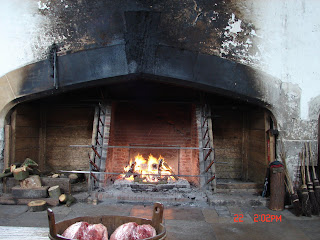Some time before Em and I left for England, I began reading Margaret George's "An Autobiography of Henry VIII." Not a REAL autobiography, but a well-researched historical novel, it was an excellent read for insight into our travels around London. One night Em, so tired she could not relax enough to fall asleep, asked me to read to her. The only book I had with me was Henry's "autobiography." I read selected parts to her and, over the following days, brought her up to speed on the story as well as continuing the readings at night per her request. She asked questions and we discussed the situations and facts. I was surprised and pleased that she was so interested, The readings and discussions bore fruit as we visited many of the places mentioned in the book and heard more stories of Henry and his Court. The look on Em's face as she connected the information to the sites, was priceless.

We spent one day at Hampton Court Palace and its gardens. Audio tapes helped us understand the various parts of the large Palace. The Tudor kitchens with authentic-looking displays, supported by recorded sounds and even some piped-in smells. were not for Henry. They were built to feed the six hundred or so members of the court, entitled to eat at the palace twice a day. Although widely known as "The Tudor Kitchens," they also served the Stuart and Georgian monarchs and were used as Royal Court kitchens for two hundred years, until 1737.
 A room was equipped for record-keeping and organization of the kitchens and their provisions.
A room was equipped for record-keeping and organization of the kitchens and their provisions. Another room held dishes.
Another room held dishes. Replicas of pies standing in the room devoted to producing pies.
Replicas of pies standing in the room devoted to producing pies.
Working in the kitchens could be a sweaty and dirty job. Henry VIII had to give orders that the scullions should stop going about ‘naked, or in garments of such vileness as they do now, nor lie in the nights and days in the kitchen or ground by the fireside’.An open hearth for roasting meat. The meat was turned on a spit before the fire to roast it on all sides. The "spit boy" sat all day turning the spit. Although this hearth appears to be outdoors under a tree, it is really soot and grease deposited on a white wall by the roasting process.
The annual provision of meat for the Tudor court stood at 1,240 oxen, 8,200 sheep, ,330 deer, 760 calves, 1,870 pigs and 53 wild boar. This was all washed down with 600,000 gallons of beer.
Two examples of recipes from the times can be downloaded here.
Realistic replicas of meat prepared for roasting on the huge hearth.
Realistic replicas of the roasted, sliced meat, complete with skewer piercings.
Several small "oven" hearths used for bread and smaller meats like fowl.
The food from these kitchens was for the 600 or so people who made the Palace function.The King's table was much more elaborate and often graced by fancy desserts.
Tickets to Hampton Court Palace were pricey but all-inclusive, and everyone was so NICE. It was a great experience and I could return many times. We got tired and over-filled our brains before we saw everything.
Live cookery will take place on the following dates:
4, 5 October / 1, 2 November / 6, 7 December /27 December - 1 Jan 20097, / 8 February 2009 / 7, 8 March 2009





To feed 600 people every day is quite a task! It must be well organised.
ReplyDeleteThank you for this interesting post!
I prefer Cooper's or your cooking best.
ReplyDeleteI got a mandolin last week, now I have to figure what to prepare that ME will eat. Talk about picky!
A food archeologist? Shoot, I think that might be my next career!
ReplyDeleteHow interesting! I haven't commented in a long time, but I have really enjoyed reading about your travels with Em. What a time you had! Em is very blessed to have such a special relationship with you. The map of your travels is astounding. Thanks for sharing your trips and photos with those of us stuck behind. :)
ReplyDelete